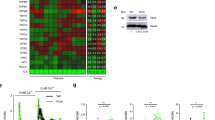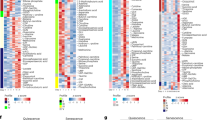Abstract
In response to tenacious stress signals, such as the unscheduled activation of oncogenes, cells can mobilize tumour suppressor networks to avert the hazard of malignant transformation. A large body of evidence indicates that oncogene-induced senescence (OIS) acts as such a break, withdrawing cells from the proliferative pool almost irreversibly, thus crafting a vital pathophysiological mechanism that protects against cancer1,2,3,4,5. Despite the widespread contribution of OIS to the cessation of tumorigenic expansion in animal models and humans, we have only just begun to define the underlying mechanism and identify key players6. Although deregulation of metabolism is intimately linked to the proliferative capacity of cells7,8,9,10, and senescent cells are thought to remain metabolically active11, little has been investigated in detail about the role of cellular metabolism in OIS. Here we show, by metabolic profiling and functional perturbations, that the mitochondrial gatekeeper pyruvate dehydrogenase (PDH) is a crucial mediator of senescence induced by BRAFV600E, an oncogene commonly mutated in melanoma and other cancers. BRAFV600E-induced senescence was accompanied by simultaneous suppression of the PDH-inhibitory enzyme pyruvate dehydrogenase kinase 1 (PDK1) and induction of the PDH-activating enzyme pyruvate dehydrogenase phosphatase 2 (PDP2). The resulting combined activation of PDH enhanced the use of pyruvate in the tricarboxylic acid cycle, causing increased respiration and redox stress. Abrogation of OIS, a rate-limiting step towards oncogenic transformation, coincided with reversion of these processes. Further supporting a crucial role of PDH in OIS, enforced normalization of either PDK1 or PDP2 expression levels inhibited PDH and abrogated OIS, thereby licensing BRAFV600E-driven melanoma development. Finally, depletion of PDK1 eradicated melanoma subpopulations resistant to _targeted BRAF inhibition, and caused regression of established melanomas. These results reveal a mechanistic relationship between OIS and a key metabolic signalling axis, which may be exploited therapeutically.
This is a preview of subscription content, access via your institution
Access options
Subscribe to this journal
Receive 51 print issues and online access
We are sorry, but there is no personal subscription option available for your country.
Buy this article
- Purchase on SpringerLink
- Instant access to full article PDF
Prices may be subject to local taxes which are calculated during checkout




Similar content being viewed by others
References
Campisi, J. Suppressing cancer: the importance of being senescent. Science 309, 886–887 (2005)
Collado, M. & Serrano, M. Senescence in tumours: evidence from mice and humans. Nature Rev. Cancer 10, 51–57 (2010)
Vredeveld, L. C. W. et al. Abrogation of BRAFV600E-induced senescence by PI3K pathway activation contributes to melanomagenesis. Genes Dev. 26, 1055–1069 (2012)
Kuilman, T., Michaloglou, C., Mooi, W. J. & Peeper, D. S. The essence of senescence. Genes Dev. 24, 2463–2479 (2010)
Lowe, S. W., Cepero, E. & Evan, G. Intrinsic tumour suppression. Nature 432, 307–315 (2004)
Adams, P. D. Healing and hurting: molecular mechanisms, functions, and pathologies of cellular senescence. Mol. Cell 36, 2–14 (2009)
DeBerardinis, R. J., Sayed, N., Ditsworth, D. & Thompson, C. B. Brick by brick: metabolism and tumor cell growth. Curr. Opin. Genet. Dev. 18, 54–61 (2008)
Tennant, D. A., Durán, R. V. & Gottlieb, E. _targeting metabolic transformation for cancer therapy. Nature Rev. Cancer 10, 267–277 (2010)
Wellen, K. E. & Thompson, C. B. Cellular metabolic stress: considering how cells respond to nutrient excess. Mol. Cell 40, 323–332 (2010)
Vander Heiden, M. G., Cantley, L. C. & Thompson, C. B. Understanding the Warburg effect: the metabolic requirements of cell proliferation. Science 324, 1029–1033 (2009)
Campisi, J. Replicative senescence: an old lives’ tale? Cell 84, 497–500 (1996)
Michaloglou, C. et al. BRAFE600-associated senescence-like cell cycle arrest of human naevi. Nature 436, 720–724 (2005)
Kuilman, T. et al. Oncogene-induced senescence relayed by an interleukin-dependent inflammatory network. Cell 133, 1019–1031 (2008)
Dankort, D. et al. BrafV600E cooperates with Pten loss to induce metastatic melanoma. Nature Genet. 41, 544–552 (2009)
Dhomen, N. et al. Oncogenic Braf induces melanocyte senescence and melanoma in mice. Cancer Cell 15, 294–303 (2009)
Davies, H. et al. Mutations of the BRAF gene in human cancer. Nature 417, 949–954 (2002)
Wieland, O. H. The mammalian pyruvate dehydrogenase complex: structure and regulation. Rev. Physiol. Biochem. Pharmacol. 96, 123–170 (1983)
Patel, M. S. & Roche, T. E. Molecular biology and biochemistry of pyruvate dehydrogenase complexes. FASEB J. 4, 3224–3233 (1990)
Kolobova, E., Tuganova, A., Boulatnikov, I. & Popov, K. M. Regulation of pyruvate dehydrogenase activity through phosphorylation at multiple sites. Biochem. J. 358, 69–77 (2001)
Roche, T. E. et al. Distinct regulatory properties of pyruvate dehydrogenase kinase and phosphatase isoforms. Prog. Nucleic Acid Res. Mol. Biol. 70, 33–75 (2001)
Holness, M. J. & Sugden, M. C. Regulation of pyruvate dehydrogenase complex activity by reversible phosphorylation. Biochem. Soc. Trans. 31, 1143–1151 (2003)
Patel, M. S. & Korotchkina, L. G. Regulation of the pyruvate dehydrogenase complex. Biochem. Soc. Trans. 34, 217–222 (2006)
Lemons, J. M. S. et al. Quiescent fibroblasts exhibit high metabolic activity. PLoS Biol. 8, e1000514 (2010)
Fantin, V. R., St-Pierre, J. & Leder, P. Attenuation of LDH-A expression uncovers a link between glycolysis, mitochondrial physiology, and tumor maintenance. Cancer Cell 9, 425–434 (2006)
Mooi, W. J. & Peeper, D. S. Oncogene-induced cell senescence–halting on the road to cancer. N. Engl. J. Med. 355, 1037–1046 (2006)
Tsai, J. et al. Discovery of a selective inhibitor of oncogenic B-Raf kinase with potent antimelanoma activity. Proc. Natl Acad. Sci. USA 105, 3041–3046 (2008)
Flaherty, K. T., Yasothan, U. & Kirkpatrick, P. Vemurafenib. Nature Rev. Drug Discov. 10, 811–812 (2011)
Frezza, C. et al. Haem oxygenase is synthetically lethal with the tumour suppressor fumarate hydratase. Nature 477, 225–228 (2011)
Frezza, C. et al. Metabolic profiling of hypoxic cells revealed a catabolic signature required for cell survival. PLoS ONE 6, e24411 (2011)
Chaneton, B. et al. Serine is a natural ligand and allosteric activator of pyruvate kinase M2. Nature 491, 458–462 (2012)
Serrano, M., Lin, A. W., McCurrach, M. E., Beach, D. & Lowe, S. W. Oncogenic ras provokes premature cell senescence associated with accumulation of p53 and p16INK4a. Cell 88, 593–602 (1997)
Sviderskaya, E. V. et al. Complementation of hypopigmentation in p-mutant (pink-eyed dilution) mouse melanocytes by normal human P cDNA, and defective complementation by OCA2 mutant sequences. J. Invest. Dermatol. 108, 30–34 (1997)
Dankort, D. et al. A new mouse model to explore the initiation, progression, and therapy of BRAFV600E-induced lung tumors. Genes Dev. 21, 379–384 (2007)
Acknowledgements
We thank J.-Y. Song for pathological analysis, M. McMahon for providing BrafCA mice, C. Vogel for sharing cell lines, R. van Amerongen for critical reading of the manuscript, and all members of the Gottlieb and Peeper laboratories for their input. This work was supported by Cancer Research UK, Spanish Government-EU-FEDER (grants SAF2011-25726 and ISCIII-RTICC-RD6/0020/0046) and ICREA-Academia to M.C., Israel Cancer Research Foundation and Israel Science Foundation to T.S., a Vici grant from the Netherlands Organization for Scientific Research (NWO) and a Queen Wilhelmina Award grant from the Dutch Cancer Society (KWF Kankerbestrijding) to D.S.P.
Author information
Authors and Affiliations
Contributions
J.K., E.G. and D.S.P. conceived the project, analysed the data and wrote the manuscript. J.K. performed all in vitro experiments and carried out the in vivo experiments together with K.M. J.K., K.M. and B.C. performed metabolic experiments. L.Z. and G.M. performed LC–MS analyses. S.H.B. and E.M.E.V. provided low passage melanoma cell lines. V.A.S., M.C. and T.S. helped with metabolic analyses. All authors discussed the results and commented on the manuscript. E.G. and D.S.P. contributed equally to this work.
Corresponding authors
Ethics declarations
Competing interests
A patent application for combined PDK and MAPK/ERK pathway inhibition in neoplasia has been filed, with J.K. and D.S.P. as inventors.
Supplementary information
Supplementary Figures
This file contains Supplementary Figures 1-15. (PDF 4632 kb)
Rights and permissions
About this article
Cite this article
Kaplon, J., Zheng, L., Meissl, K. et al. A key role for mitochondrial gatekeeper pyruvate dehydrogenase in oncogene-induced senescence. Nature 498, 109–112 (2013). https://doi.org/10.1038/nature12154
Received:
Accepted:
Published:
Issue Date:
DOI: https://doi.org/10.1038/nature12154
This article is cited by
-
Phosphoglycerate dehydrogenase activates PKM2 to phosphorylate histone H3T11 and attenuate cellular senescence
Nature Communications (2023)
-
PDK4-dependent hypercatabolism and lactate production of senescent cells promotes cancer malignancy
Nature Metabolism (2023)
-
Hypoxia-induced reprogramming of glucose-dependent metabolic pathways maintains the stemness of human bone marrow-derived endothelial progenitor cells
Scientific Reports (2023)
-
RBM4 dictates ESCC cell fate switch from cellular senescence to glutamine-addiction survival through inhibiting LKB1-AMPK-axis
Signal Transduction and _targeted Therapy (2023)
-
Complex Interplay Between Metabolism and CD4+ T-Cell Activation, Differentiation, and Function: a Novel Perspective for Atherosclerosis Immunotherapy
Cardiovascular Drugs and Therapy (2023)



